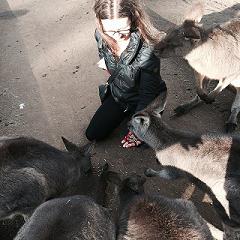|
|
Sweetness!
Posted by:
dave6
()
Date: January 13, 2007 03:53PM Hi everyone!
I have just bought the Naked chocolate book by David Wolfe and Shazzie. Alot of there recipes contain raw Agave nectar and i have been reading different views on its health benefits. What do you think? Does anybody here use it? I love the taste of Agave and it would be great if it was good for you! David Re: Sweetness!
Posted by:
na(raw)dia
()
Date: January 13, 2007 04:03PM Can you post some recipes out of that book...? I've been wanting to buy it but have heard mixed reviews...too difficult? What do you think?
As far as Agave...I think that it's one of those foods that should be very limited. Moderation is key. Re: Sweetness!
Posted by:
rosemary
()
Date: January 13, 2007 04:13PM i tend to mix my sweeteners- dried fruit/dates, stevia, xylitol,agave, raw honey. they taste better combined, and i don't overdo it on 1. Re: Sweetness!
Posted by:
dave6
()
Date: January 13, 2007 05:36PM Spicy hazelnut clusters
8 dates, soaked and stoned 1 1/2 cup of dried baby figs 2 cups of hazelnuts 2 tablespoons of raw agave nectar 1/2 cup of chocolate powder (crushed cacao, beans or nibs) pinch of sea salt or Himalayan pink rock salt Put the hazelnuts in the food processor and process until broken not powder. Put all the remaining ingredients into food processor and process until mixture starts to form a ball. Then just make balls with the mixture. Pretty simple, a lot of the recipes are easy and taste amazing! Really Chocolate Pudding 1/2 cup of chocolate powder 1 avacado, stoned and peeled 1/2 cup of carob powder 10 dates, stoned and soaked 2 tablespoons of raw agave nectar Blend all ingredients together. The book has a lot of recipes well worth the buy. There is a 3 layer chocolate cake for the hardcore chocolate fans, think i will stick with the simple recipes for now. David Re: Sweetness!
Posted by:
Funky Rob
()
Date: January 14, 2007 12:29AM I've just started using the dark agave and I love it. The dark has more minerals than the light which is more refined.
I'm not sure it's the most nutritious food in the world, but in moderation, I think it's fine! I've just got Naked Chocolate too, only made one recipe and it was ok, but it used cashews and I don't think regular (non raw) cashews are good which is what I used. Rob -- Rob Hull - Funky Raw My blog: [www.rawrob.com] Re: Sweetness!
Posted by:
la_veronique
()
Date: January 14, 2007 02:21AM cacao has made me feel loopy weird elated whoaaaahhh ahhhhh hmmmm.. uhhhh. huhhhh??? sometimes Re: Sweetness!
Posted by:
brome
()
Date: January 14, 2007 09:23PM The Agave plant stores energy for a massive flowering for years. Just before it flowers it can be tapped for aquamiel, the sweet sap ment for the massive sprout that was to be. This is a true sprout juice from the rapidly developing embryonic process in the plant, full of the simple sugars, amino acids, enzymes, etc that you would find in any sprout. It is sold in Agave growing areas in Mexico by the side of the road (maybe worth a trip). Aquamiel is the source of the above mentioned Agave nectar and is also fermented to make pulque a popular alcoholic drink.
[www.newfarm.org] Aguamiel The leaves of the Agave grow on a short stalk, the base of which is called a piña— picture a huge pineapple growing underground with only the top leaves emerging from the surface. The species used most frequently in the production of alcohol grow for 8 to 15 years before they show signs of flowering. At this point, the leaves are cut from one side of the plant to allow access to the heart. In a process called “castration”, a hole is carved into the top of the piña where the flower would have grown and the heart of the plant is removed. The hole is left full of plant material and scrapings for a month or more before it is cleaned out and the sides of the hole rescraped. The nourishment which the plant would have used for the huge flower then begins to seep from the sides and gather in the newly created depression as a sweet sap called aguamiel (necutli in Náhuatl). The aguamiel is collected from the piña by the tlachiquero, who scoops or sucks it out with a long tube up to three times a day for several months. During that time, the plant produces three to four liters of this nectar each day. Aguamiel can be harvested and consumed straight or used as the source of a number of beverages. Atole, for example, is a nonalcoholic beverage made from hot cornmeal and unfermented aguamiel. Sorry, only registered users may post in this forum.
|
|



